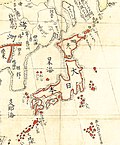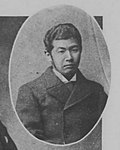the 1680s and 1770s in Kyoto and Osaka. Ukiyo-zōshi literature developed from the broader genre of kana-zōshi, books written in the katakana vernacular...
33 KB (4,391 words) - 00:16, 9 May 2024
belongs to Ihara's floating world genre of Japanese literature (浮世草子 Ukiyo-zōshi), and contains eight sections; each section contains five chapters, making...
6 KB (738 words) - 08:21, 1 November 2024
Japanese poet and creator of the "floating world" genre of Japanese prose (ukiyo-zōshi). Born as Hirayama Tōgo (平山藤五), the son of a wealthy merchant in Osaka...
9 KB (1,165 words) - 23:41, 7 August 2024
"The Man Who Spent His Life in Love") inaugurates what becomes known as ukiyo-zōshi ("books of the floating world"), the first major genre of popular Japanese...
4 KB (386 words) - 18:29, 18 June 2024
yōkai they were intending to depict. The Kōshoku Haidokusan (好色敗毒散), a ukiyo-zōshi published in the Edo Period gives the example, "its form was nurarihyon...
14 KB (1,949 words) - 17:28, 20 September 2024
years. During this time, he published several humorous stories in the ukiyo-zōshi style, literally translated as "tales of the floating world". Taking...
6 KB (830 words) - 15:37, 19 August 2023
lives, which came to be called the ukiyo ("floating world"). This lifestyle inspired ukiyo-zōshi popular novels and ukiyo-e art, the latter of which were...
137 KB (16,278 words) - 12:17, 15 November 2024
because it had become less popular in Ueda's time with the rise of ukiyo-zōshi. Tales of Moonlight and Rain is the most common English translation;...
37 KB (3,926 words) - 12:45, 18 February 2024
relationships was common, with perhaps the most well-known collection being ukiyo-zōshi poet Ihara Saikaku's The Great Mirror of Male Love. Classical studies...
40 KB (4,870 words) - 22:51, 1 November 2024
Medieval Japan was a time period where publications such as emakimono, Otogi-zōshi, and other visual depictions of yōkai started to appear. While there were...
42 KB (4,672 words) - 00:02, 12 November 2024
Asai Ryōi (redirect from Ukiyo Monogatari)
(浮世物語, Ukiyo Monogatari, 1666) is widely considered the first work to revel in the difference between Buddhist ukiyo and Edo period ukiyo. Ukiyo was the...
4 KB (447 words) - 05:26, 31 January 2022
Genji, Narihira figured prominently in Edo-period ukiyo-e prints and was alluded to in the ukiyo-zōshi of Ihara Saikaku. The 16th-century warrior Ōtomo...
45 KB (4,472 words) - 19:58, 11 September 2024
Okumura Masanobu (category Ukiyo-e artists)
provided the illustrations, and sometimes text, for at least twenty-two ukiyo-zōshi novels and librettos for puppet theatre between 1703 and 1711. These...
9 KB (1,245 words) - 16:46, 28 October 2024
Publishing Co., 1897 Kyōkashuu (狂歌集) Aoki Sūzandō Publishing Co., 1898 Ukiyo-zoshi (浮世草紙) Aoki Sūzandō Publishing Co., 1898 Tsuta no Hozomichi (蔦の細道) Aoki...
12 KB (1,425 words) - 15:05, 14 February 2024
Japanese poet and creator of the "floating world" genre of Japanese prose, ukiyo-zōshi Thomas Shadwell (died 1692), English poet and playwright appointed poet...
4 KB (344 words) - 19:39, 27 June 2024
generations. Komatsu infers that despite the depictions in Bakumatsu period ukiyo-e art leading to a resurfacing of the idea, these were all produced in an...
18 KB (2,275 words) - 17:41, 5 November 2024
where these are sold". The word hariya also features in Saikaku's 1688 ukiyo-zōshi The Eternal Storehouse of Japan (日本永代蔵, Nippon Eitaigura), as a byword...
10 KB (1,049 words) - 22:46, 5 November 2023
Laozi all go to a brothel in Ōsaka. Early sharebon were influenced by ukiyo-zoshi – which became popular in the late 17th century – and directly followed...
12 KB (1,515 words) - 12:29, 17 September 2023
September 9 – Ihara Saikaku (born 1642), Japanese poet and creator of the ukiyo-zōshi ("books of the floating world") genre of prose fiction December 13 –...
4 KB (369 words) - 16:05, 31 August 2024
E-hon (category Ukiyo-e genres)
17th-century. The contents of these manuscripts consists mostly of otogi-zōshi which are short narratives concerning war epics, folklore or Shinto and...
9 KB (978 words) - 14:32, 29 December 2022
(Itō junsa no shi) co-direction 1924: Chronicle of the May Rain (Samidare zōshi) 1924: Love-Breaking Axe (Koi o tatsu ono) co-direction 1924: Kanraku no...
30 KB (3,332 words) - 15:57, 11 October 2024
Lane, Richard (1957). "The Beginnings of The Modern Japanese Novel: Kana-zōshi, 1600-1682". Harvard Journal of Asiatic Studies. 20 (3/4): 644–701. doi:10...
9 KB (1,146 words) - 20:46, 9 November 2023
world antique market. Tsuchigumo Sōshi Rashōmon no oni Rashōmon (otogi-zōshi) Kidōmaru Heike Tsuruginomaki 'Onikirimaru' has the same name as the sword...
20 KB (2,668 words) - 00:17, 1 August 2024
featuring Western-style clothes and hairstyle. Kikugorō was a popular figure in ukiyo-e woodblock prints, especially in those by Toyohara Kunichika. He was also...
8 KB (870 words) - 13:55, 7 October 2024
the Itsuō Art Museum. It was later incorporated into the corpus of Otogi-zōshi ("Companion tales"), and became widely read in the woodblock-printed versions...
38 KB (4,919 words) - 04:35, 13 November 2024
of Sōjōbō and Yoshitsune is the otogi-zōshi story called Tengu no dairi (The Palace of the Tengu). Otogi-zōshi is a genre of Japanese fiction that was...
35 KB (4,119 words) - 17:54, 20 September 2024
(2012). "Gendering the Court Woman Poet: Pedigree and Portrayal in "Fukuro zōshi"". Monumenta Nipponica. 67 (2): 201–238. doi:10.1353/mni.2012.0017. ISSN 0027-0741...
15 KB (1,055 words) - 22:50, 16 November 2024
before the versions in 19th century textbooks, there had been the otogi-zōshi versions from the Muromachi period. Conventionally, commentators using the...
70 KB (8,031 words) - 19:23, 3 October 2024
as the Shinkō-ji copy (1323), rather burlesque in the vein of the otogi-zōshi movement, the Miei-dō copy (second half of the 14th or early 15th century)...
47 KB (5,208 words) - 00:19, 13 September 2024
Santō Kyōden (category Ukiyo-e artists)
which he would continue to use up until his death. Ukiyo-e Kyōden began his career by studying ukiyo-e or woodblock prints which typically depicted "the...
37 KB (4,635 words) - 01:20, 12 May 2024





















